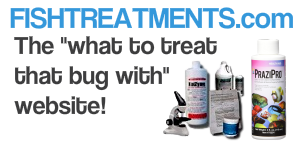The treatment of fish disease is a subject fraught with difficulties and misunderstandings. This is in part due to the need to oversimplify of what is a complex subject.
In all probability there are as many fish killed, directly or indirectly, by ‘medications’ as there are cured. I am sure that we would all agree that this would be totally unacceptable with any other companion animal. Just imagine the uproar if cats and dogs routinely died as a result of treatments for fairly minor ailments!
Clearly, the main reason that other animals fare better is that they are usually treated by trained professionals, i.e. veterinarians, whereas fish, by and large, are treated by their owners. There are broadly three reasons why treatments often fail:
1. An inaccurate diagnosis (or guess) is made as to the nature of the problem, which in turn results in the wrong treatment being used. This is often the situation where ‘dartboard’ medication is used, whereby, a guess is made as to the nature of the disease (usually based solely on clinical signs rather than an examination) and a succession of different treatments is applied in the hope that one of them will work. This can often exacerbate an existing condition or mean that the condition simply gets worse. This really is a ‘kill or cure’ approach – sadly too often a kill result. An accurate diagnosis is essential if health problems are to be treated effectively.
2. An accurate diagnosis is made but the selected treatment is not successful: Treatments may be unsuccessful for a variety of reasons. In some cases the germs and bugs (pathogens) are resistant to a particular treatment. It is not unusual for a treatment that works in one pond to be less successful against the same parasite in another pond. In such a situation another appropriate treatment should be used.
Another common problem that affects some disease treatments are variations in water chemistry. In these situations, water parameters such as hardness, pH or organic load can interfere with the action of the treatment, rendering it ineffective. There are also situations, particularly with severe parasite infestations, where, because of the host’s reactions to their presence, the parasites are protected by excess mucus.
3. A straightforward treatment overdose: This can arise from a simple miscalculation of dosages, or by the toxicity of the treatment being affected by water conditions such as pH and hardness.
A fourth reason stems, I believe, from a misunderstanding of the nature of many treatments used to combat disease problems. We can divide typical treatments into two types. First are the ‘proper’ medications that have been formulated specifically to fight known pathogens. These would include antibiotics and other types of veterinary drugs and medicines. These tend to target the disease-causing organism, and while there may be some side effects, are unlikely to directly harmful to the patient at the correct doses.
The other class of treatments, and those most likely to be used by the hobbyist, are not medications in the accepted sense, but chemicals taken directly from the chemistry lab!
Their action is usually far less discriminatory. They are usually toxic to all life-forms at relatively low doses. The effective dose is one that is high enough to kill the smaller organisms such as parasites, but not high enough to kill larger animals such as fish. The safety margin is usually very fine. It is important for hobbyists to appreciate that the majority, including most proprietary treatments, work in this fashion and that such treatments should not be used in a cavalier fashion.
A further consideration are variations in water chemistry. Most chemicals, with the exception of salt, are affected to some degree by variances in water hardness, pH and temperature. Many chemicals also react with dissolved and particulate organic matter such as fish waste, algae and detritus – thus affecting or reducing their efficacy.
The three most important steps are 1) an accurate diagnosis.2) an accurate dosage calculation and 3) a follow-up examination to monitor the effectiveness of the treatment.
When applying any treatments
- Make sure that the water is well oxygenated as many treatments can remove oxygen from the water. This is particularly important with any formalin-based treatments.
- Turn off any UV lights as the ultraviolet radiation may degrade or affect the chemical.
- Consider whether it is necessary to by pass the filter system to avoid adversely affecting the filter biomass. This would in turn result in a loss of water quality, which would simply make the situation worse.
- Keep a close eye on fish under treatment as even at the correct doses some may react badly. Always be prepared to terminate a treatment under such circumstances. Consideration should be made as to how a treatment could be rapidly diluted if needed.
- Many treatments are degraded in strong sunlight, particularly potassium permanganate.
- Consider netting the pond as fish may well jump out when treatments are applied.

